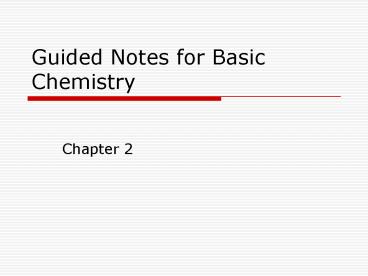Guided Notes for Basic Chemistry - PowerPoint PPT Presentation
1 / 28
Title:
Guided Notes for Basic Chemistry
Description:
Guided Notes for Basic Chemistry Chapter 2 Matter is anything that occupies space and has mass. Matter exists in solid, liquid, and gaseous states. – PowerPoint PPT presentation
Number of Views:426
Avg rating:3.0/5.0
Title: Guided Notes for Basic Chemistry
1
Guided Notes for Basic Chemistry
- Chapter 2
2
- Matter is anything that occupies space and has
mass. Matter exists in solid, liquid, and
gaseous states.
3
3 Types of Matter in the Body
- Solids bones, teeth
- Liquids blood, plasma
- Gases air
4
- 3. Energy is commonly defined as the ability to
do work or to put matter into motion.
5
- 4. Chemical energy is stored in the bonds of
chemical substances. When the bonds are broken,
it becomes kinetic energy.
6
- 5. Electrical energy results from the movement
of charged particles.
7
- 6. Mechanical energy is directly involved in
moving matter. Radiant energy travels in waves,
that is, energy of the electromagnetic spectrum.
8
- 7. Four elements, carbon, oxygen, hydrogen, and
nitrogen, make up about 96 percent of body weight.
9
- 8. Isotopes are atoms that exhibit two or more
structural variations. Isotopes have the same
number of protons and electrons, but vary in the
number of neutrons.
10
- 9. Radioisotopes are the heavier isotopes of
certain atoms, which are unstable and tend to
decompose to become more stable. Radioisotopes
are used in minute amounts to tag biological
molecules so that they can be followed, or
traced, through the body.
11
- 10. A water molecule is formed when two hydrogen
atoms bind covalently to one oxygen atom.
12
- 11. Synthesis reactions occur when 2 or more
atoms or molecules combine to form a larger, more
complex molecule.
13
- 12. Decomposition reactions occur when a
molecule is broken down into smaller molecules.
Examples of decomposition reactions that occur in
the body include the digestion of foods and the
breakdown of glycogen.
14
- 13. During exchange reactions, a switch is made
between molecule parts and different molecules
are made. An exchange reaction occurs when ATP
reacts with glucose.
15
Difference between organic and inorganic compounds
- Organic Compounds contain carbon
- Inorganic Compounds do not contain carbon (except
for carbon dioxide)
16
- 15. When dissolved in body fluids, salts, which
are ionic compounds, easily separate into their
ions.
17
- 16. Because ions are charged particles, all
salts are electrolytes, which are substances that
conduct an electrical current in solution. When
electrolyte balance is severely disturbed,
virtually nothing in the body works.
18
- 17. Living cells are extraordinarily sensitive
to changes in pH, and the acid-base balance is
carefully regulated by the kidneys, lungs, and
chemicals called buffers.
19
- Carbohydrates, which include sugars and starches,
contain carbon, hydrogen, and oxygen.
Carbohydrates are classified according to size as
monosaccharides, disaccharides, or
polysaccharides.
20
The 3 Types of Carbohydrates
- Monosaccharides glucose
- Disaccharides sucrose, lactose
- Polysaccharides starch, glycogen
21
- 20. The most abundant lipids in the body are
neutral fats, phospholipids, and steroids. All
lipids contain carbon, hydrogen, and oxygen. Most
lipids are insoluble in water.
22
- 21. The single most important steroid molecule is
cholesterol, which enters the body in animal
products such as meat, eggs, and cheese.
23
- 22. Proteins account for over 50 percent of the
organic matter in the body, and they have the
most varied functions of organic molecules.
24
- 23. The building blocks of proteins are small
molecules called amino acids.
25
- 24. Based on their overall shape and structure,
proteins are classified as either fibrous or
globular.
26
Fibrous Proteins
- Fibrous proteins are strand-like and bind
structures together - Examples include keratin and collagen
27
Globular Proteins
- Globular proteins are mobile, generally spherical
molecules that play crucial roles in biological
processes - Examples include antibodies, hormones, and enzymes
28
- 27. ATP is all-important because it provides a
form of chemical energy used by all body cells.
Without ATP, molecules cannot be made or broken
down, cells cant maintain boundaries, and life
processes stop.































